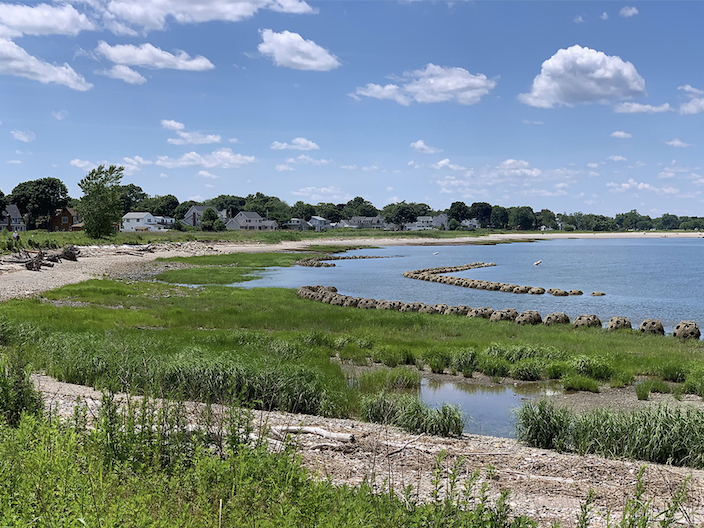

FAIRFIELD, Conn. — Stratford Point Living Shoreline, a research project headed by Sacred Heart University biology professor Jennifer Mattei with members of her lab, has received the Best Restored Shore Award from the American Shore & Beach Preservation Association (ASBPA). Mattei will be honored at the virtual 2020 ASBPA National Coastal Conference Oct. 15, when she will present her project results.
The living shoreline is part of a peninsula in Stratford’s Lordship section, near the mouth of the Housatonic River. It comprises artificial “reef balls;” smooth, cordgrass marsh; high marsh; coastal dunes and coastal forest/grassland mosaics. Its purpose is to establish a shellfish reef, establish natural protections against wave energy and disrupt coastal erosion.
What started in 2014 as a 150-foot research project —with support and participation from the land owner, Corteva Agriscience—has grown into the largest living shoreline in New England. After restoration efforts resulted in more than a foot of sediment accumulation and marsh recovery, the project received grants from the National Fish & Wildlife Foundation, Connecticut Institute for Resilience and Climate Adaptation (CIRCA), the National Oceanic and Atmospheric Administration and the U.S. Army Corps of Engineers Connecticut In-Lieu Fee Program, which is sponsored by Audubon Connecticut. This funding allowed for expansion of the living shoreline, which now provides an additional 750 feet of coastal erosion control and resiliency, four acres of intertidal habitat, one acre of coastal dune habitat and 25 acres of woodland and meadow habitat.
When dealing with rising sea levels, “people’s initial reaction to erosion is to build a wall,” Mattei observed. “We now know that sea-level rise and increased storm intensity undermine sea walls. Storm waves engulf walls, and trapped water causes flooding. Walls erode and collapse, and reconstruction is costly. The solution, as Stratford Point Living Shoreline demonstrates, is to re-establish the missing habitat to protect the shoreline, hold the sediment and increase resilience.”
Nature-based solutions provide nursery habitats for commercially important fish species and shellfish that filter and clean the water at greatly reduced costs compared to armoring shorelines. The Stratford Point Living Shoreline is used as a model for other coastal communities, demonstrating the services gained by using nature-based solutions to erosion.
Mattei hopes the ASBPA award shines a light on the project and brings attention back to environmental issues in the U.S. “Climate change is not going away. Property owners need to get together and start revegetating and repopulating their shoreline with oysters and shellfish to protect their properties,” she said. “Ultimately, we need to be better stewards of Long Island Sound because it gives us so much in return.”
“Stratford Point is part of an Audubon Important Bird Area and it has been incredible to see saltmarsh, seaside, and Nelson’s sparrows in the re-established salt marsh habitat,” said Corrie Folsom-O’Keefe, director of bird conservation for Audubon Connecticut, a project partner. "The Long Island Sound ecosystem is critical to the health of birds and safety of coastal communities, and we need more projects like the Living Shoreline at Stratford Point to serve as models for success.”
###
About Sacred Heart University
As the second-largest independent Catholic university in New England, and one of the fastest-growing in the U.S., Sacred Heart University is a national leader in shaping higher education for the 21st century. SHU offers more than 80 undergraduate, graduate, doctoral and certificate programs on its Fairfield, Conn., campus. Sacred Heart also has satellites in Connecticut, Luxembourg and Ireland and offers online programs. More than 9,000 students attend the University’s nine colleges and schools: Arts & Sciences; Communication, Media & the Arts; Social Work; Computer Science & Engineering; Health Professions; the Isabelle Farrington College of Education; the Jack Welch College of Business & Technology; the Dr. Susan L. Davis, R.N., & Richard J. Henley College of Nursing; and St. Vincent’s College. Sacred Heart stands out from other Catholic institutions as it was established and led by laity. The contemporary Catholic university is rooted in the rich Catholic intellectual tradition and the liberal arts, and at the same time cultivates students to be forward thinkers who enact change—in their own lives, professions and in their communities. The Princeton Review includes SHU in its Best 386 Colleges–2021 Edition, “Best in the Northeast” and Best Business Schools–2020 Edition. Sacred Heart is home to the award-winning, NPR-affiliated radio station, WSHU, a Division I athletics program and an impressive performing arts program that includes choir, band, dance and theater. www.sacredheart.edu